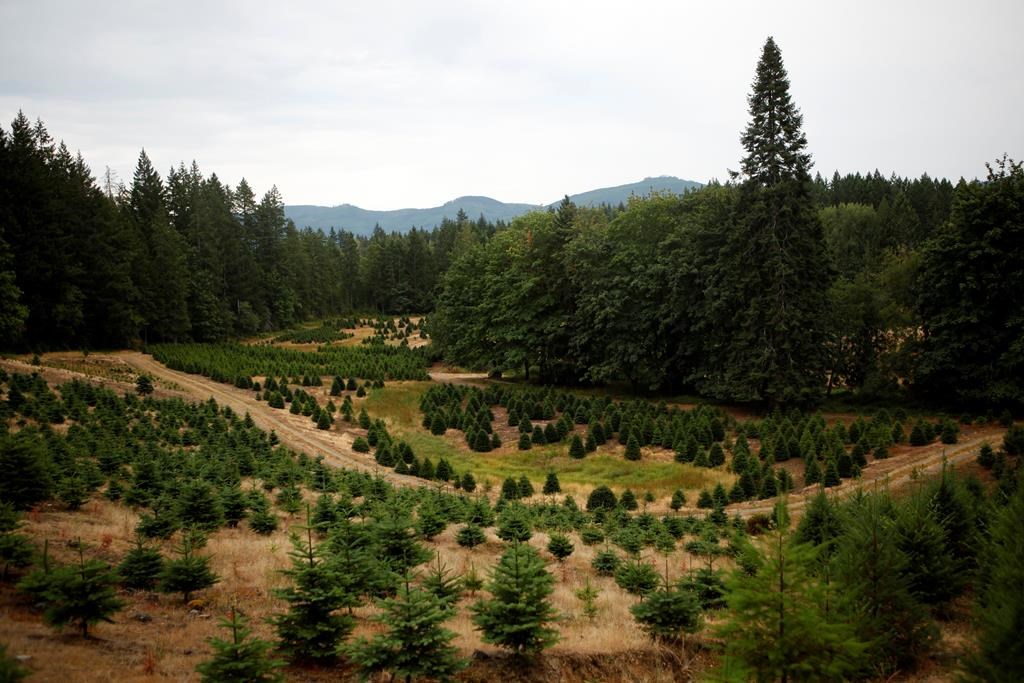Climate change affecting Christmas trees in B.C. and beyond: expert

The effects of climate change are taking a toll on Christmas tree farms in British Columbia and beyond, with one forestry expert saying the sector that’s already shrinking and shifting will need to adapt in the coming years.
The trees take eight to 12 years to reach the size most people are looking for, and young seedlings are particularly vulnerable to climate risks, said Richard Hamelin, head of the forest conservation sciences department at the University of B.C.
Much of the province has experienced prolonged drought and extreme heat over the last two summers, and the seedlings have shallow root systems that don’t reach beyond the very dry layers of soil near the surface, Hamelin explained.
Advertisement
Those same shallow roots meant swaths of seedlings were swamped or washed away during extensive flooding fuelled by so-called atmospheric rivers of rain throughout southwestern B.C. in November 2021, Hamelin said in an interview.
On top of that, wet, cool soils increase the risk of root diseases, he noted.
Meanwhile, older trees may survive but lose their needles or turn brown as a result of extreme heat and drought, he added.
The severe atmospheric rivers last fall and the so-called heat dome of 2021 that saw Lytton, B.C., break the all-time record for highest daily temperature ever recorded in Canada have both been linked to the effects of climate change.
Although Quebec, Ontario and Nova Scotia lead the country when it comes to producing Christmas trees, Hamelin said he expects the successive extreme weather events in B.C. will contribute to an ongoing shortage for years to come.
Advertisement
Climate change is also causing warmer weather overall, fuelling activity among pests that can plague trees already weakened by drought or disease, he said.
“Just like humans, when we are stressed or when we’re more tired, we’re more susceptible to diseases,” said Hamelin. “Well, trees are the same way. So all this added stress from all this heat and flooding make the trees more susceptible to pests and pathogens.”
Tree farm closures affecting availability of Christmas trees
Climate change is not the only factor challenging farmers and threatening Canada’s stock of real Christmas trees, which has been declining for several years.
Since the trees take about a decade to reach the desired size, the closure of tree farms in Canada and the United States during the 2008 recession is now being felt.
The closures continued, with Statistics Canada data showing the total area of Christmas tree farms shrunk by nearly 20,000 acres between 2011 and 2021.
Advertisement
Shirley Brennan, the executive director of the Canadian Christmas Trees Association, said the average age of a tree farmer is between 65 and 85 years old, and younger generations aren’t entering the sector as longtime farmers retire.
However, there is a “light at the end of the tunnel” that comes in the form of agritourism, Brennan said in a recent interview.
Rather than opening for just six weeks in the winter, farms can look at diversifying their operations to grow crops like lavender, host activities such as yoga retreats or incorporate pumpkin picking as Brennan’s own farm has done, she said.
The high cost of land and competition with crops that yield revenue more quickly than festive trees may be an inhibiting factor for the sector in B.C., Hamelin noted.
Advertisement
Hamelin pointed to some additional options that could help Christmas tree farmers weather the effects of global heating, including genetically selecting and breeding the strongest trees among classic Canadian species,or importing different species of fir trees from parts of the world where they’re better adapted to sweltering heat.
The plantation-like approach to Christmas tree farming is also “completely unnatural,” leaving seedlings and young trees exposed to the sun, he said.
Christmas tree farmers could consider letting some trees grow taller, or planting seedlings in areas where more mature trees could provide some shade, he said.
“I think there are some solutions, we just need to scratch our head and realize that things are different, and in the future we just need to change the way we do things,” said Hamelin.
